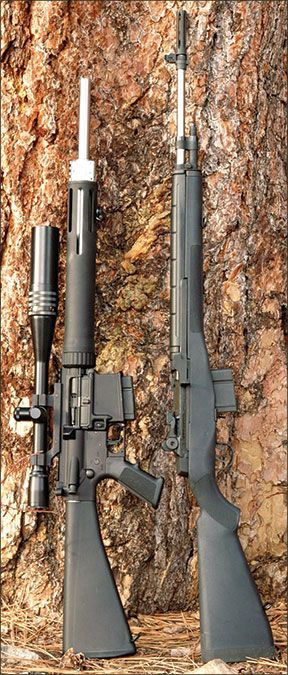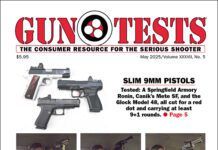In the March 2014 issue, we tested a SIG Sauer 716 Patrol and a Rock River Arms LAR-8. We now take a look at two more semi-auto 308 Winchester Rifles, an ArmaLite AR-10(T), $1914, and a Springfield M1A Loaded, $1893. These two rifles serve a slightly different purpose from the two previously tested, being put together with serious target work in mind. Both had match-grade stainless barrels and black plastic stocks, and thats about all the similarities. There were no iron sights with the ArmaLite, but the M1A had fine ones. We knew wed be pitting a target scope against iron sights, but never expected the results we got. We tested with the same three ammo types used in our March 2014 report on the SIG and Rock River, Freedom Munitions 150-grain FMJs, Federal Match 168-grain Match Kings, and Hornady 155-grain JHPs. Lets take a look at what you get with each of these target rifles.

Springfield Loaded M1A MA98267.62x51mm NATO/308 Winchester, $1893
The M1A Springfield had a stainless match barrel with a mighty long sight radius, so we chose to shoot it with its very fine iron sights, much as one would have to in a match. We confess to a weakness for this rifle type over all the other black-rifle types tested, for several reasons. First, most of our test crew think it looks like a rifle ought to look. Okay, if you dont like that reason, its less military in its look in todays market, and that can make you some friends along the way. More important, most of our shooters much prefer the feel of the M1A rifle over the pistol-grip setup of the black rifles. To them, its much more natural and comfortable. We would have preferred a wood stock, and you can get one for it, but this black plastic one was in keeping with the other test rifles. The Springfield Loaded rifle has match-grade accessories that include the sights, flash hider, trigger, and barrel (1-in-11-inch twist). There are four versions of this rifle, with two types of barrel and two types of stock. With the choice of a walnut stock, the price goes to $2005. With the walnut stock and a carbon-steel match-grade barrel, still with all the other goodies, the price is $1908. With the plastic stock and carbon-steel match barrel, the price drops to $1794. So the stainless barrel is about $100 extra, and the walnut stock is about $110 extra, give or take a bit.
The excellent Springfield website (Springfield-Armory.com) gives details on these choices.
The stock was nicely configured and had checkered areas where your fingers go. The checkering angle was not normal, but it gave good traction, and thats what counts. The stock had a very thick and very hard rubber recoil pad. Why put one on if its this hard? It closes the stock, of course. The stock is hollow to some extent, so a trap in the butt somewhere, somehow, would have been useful, but there was none.
The receiver was Springfields time-tested investment casting, with a fine Parkerized finish. There was a gate mounted on top of the ejection port for stripper-clip use, just like the original M14 rifles had. The sighting radius was enormous, a full 27 inches, much better than the best distance of any of the M16 look-alikes. If the ArmaLite were fitted with iron sights, the radius would be only about 20 inches. The M1As rear sight was fully and finely adjustable for windage and elevation, with positive click stops. You get half a minute of windage and one minute of elevation per click. The aperture was too small for fast shooting, but ideal for serious target shooting.
The barrel was marked NM 308 SS, for National Match, the caliber, and stainless steel. There was no finish on the barrel itself. The NM flash hider with front-sight mount was Parkerized, as were the thin match-type front sight-blade and all of the gas-port metal. The two-stage trigger pull was a touch on the stiff side at 5.3 pounds, but clean and consistent. We took the rifle out of the stock to inspect inside, and everything looked pretty good.
The first thing we didnt like was the safety lever. Putting it on invariably pinched our finger. The pressure needed to put the safety on was enough to permit our finger to get between the safety lever and the trigger guard, and we got nailed every time. Another rifle on hand of the same type never pinched our finger. We dont know how to cure it, but did not like it.
Another situation we didnt like was the great force needed to insert or remove the magazines. Several we tried were all a force fit, which is not right. There was drag from both the plastic stock and from the metalwork, which left a scarred surface on the side of the magazine. A rifle costing this much and supposedly set up for match shooting – which will most likely involve rapid reloading at some point – needs to have everything about it just right, and as delivered, this one had a big problem with magazine fit.
Despite the careless fitting of the rifles magazine well, the M1A was one accurate rifle. With its iron sights, it outshot the ArmaLite fitted with a 36X scope. Our best groups were with Federals Match ammo, which averaged 0.7 inches. That kind of accuracy does not come easily, and of the two test rifles wed far and away choose the M1A if we wanted the most accurate target rifle. This one didnt do too well with the low-cost Freedom ammo (available from FreedomMunitions.com #FM308F150R-B0020, $12.83/20), averaging 3 inches at 100 yards, which was about as well as it did with the Hornady Match. We note that its possible to fit a scope to the M1A with several different mount types, if that is needed.
ArmaLite AR-10(T)Black Target Rifle 10TBNF308 Winchester, $1914
Although the ArmaLite had the basic black-rifle setup, it had a thick stainless match barrel and a tubular forend. The rifle came with no iron sights, so we again called on our 36X Weaver target scope to wring out the rifle. This was one heavy dude. With our scope bolted in place, no ammo, the rifle tipped the scales at 12 pounds, enough to give the shooter a good iron-pumping workout by simply lifting it without firing a shot. The heavy 20-inch barrel measured 0.8 inch in diameter at the muzzle. The trigger pull was a two-stage unit. It took about 3 pounds for the first stage, and broke at 5.0 pounds, dead clean.
The heavy tubular forend fit our machine rest nicely, and was comfortable to grasp. This aluminum forend provided a circular shield for the free-floated barrel. Its bottom had seven threaded holes to give a variety of positions for a sling. The magazine went in and came out cleanly, just like it was supposed to.
Takedown was standard, and offered no surprises. Looking inside the rifle, we found fine workmanship everywhere we looked, though nothing appeared to jump out as being special. The details on such a rifle are, of course, what make the difference, and these can be subtle in the extreme. The stock and pistol grip seemed to be standard items. The stock had a useful trap in its butt, but the pistol grip was simply hollow. The trigger guard could be opened for winter use, like the guards on the other two rifles tested previously.
On the range, using our machine rest with the round forend, we could hold the tiny dot of the 36X scope absolutely motionless on the target, so we knew we were getting all we could out of the rifle. With the Federal ammo it shot its best, giving groups that averaged 1.2 inches, not quite the minute-of-angle promised by the maker. However, our groups had all three shots in a horizontal line, promising one-hole groups if we could determine the cause of the slight windage movement. In short, with more shooting, we might have done better. With Hornadys ammo, the rifle averaged the same, and it gave the rifles best group at 0.9 inch. That beat the Hornady-ammo groups we got with the M1A significantly, though all our shooting was somewhat limited by bad weather.
Our Team Said
Nearly everything about the Springfield M1A Loaded 308 Winchester worked really well. The iron sights were very easy and predictable to adjust, which is done by twirling the two wheels, one for windage and one for elevation. Other than the poor magazine fit and the constant pinching by the safety lever, we could not fault the rifle. We would expect the factory to have done a better job of fitting the mag well, so we had to downgrade the rifle for that. We expect both issues to be covered by warranty work.
We could not fault the ArmaLite AR-10(T) Black Target Rifle 10TBNF in any way. It exhibited decent accuracy with both types of match ammo, and promised more accuracy than we got. It was way too heavy, we thought, for a general-purpose battle rifle, and for that it would have needed iron sights, too. However, if you want or need a good black target rifle, here it is.
Written and photographed by Ray Ordorica, usingevaluations from Gun Tests team testers. GT




























